spare wheel Lexus GS350 2011 Owner's Manual
[x] Cancel search | Manufacturer: LEXUS, Model Year: 2011, Model line: GS350, Model: Lexus GS350 2011Pages: 654, PDF Size: 11.03 MB
Page 542 of 654
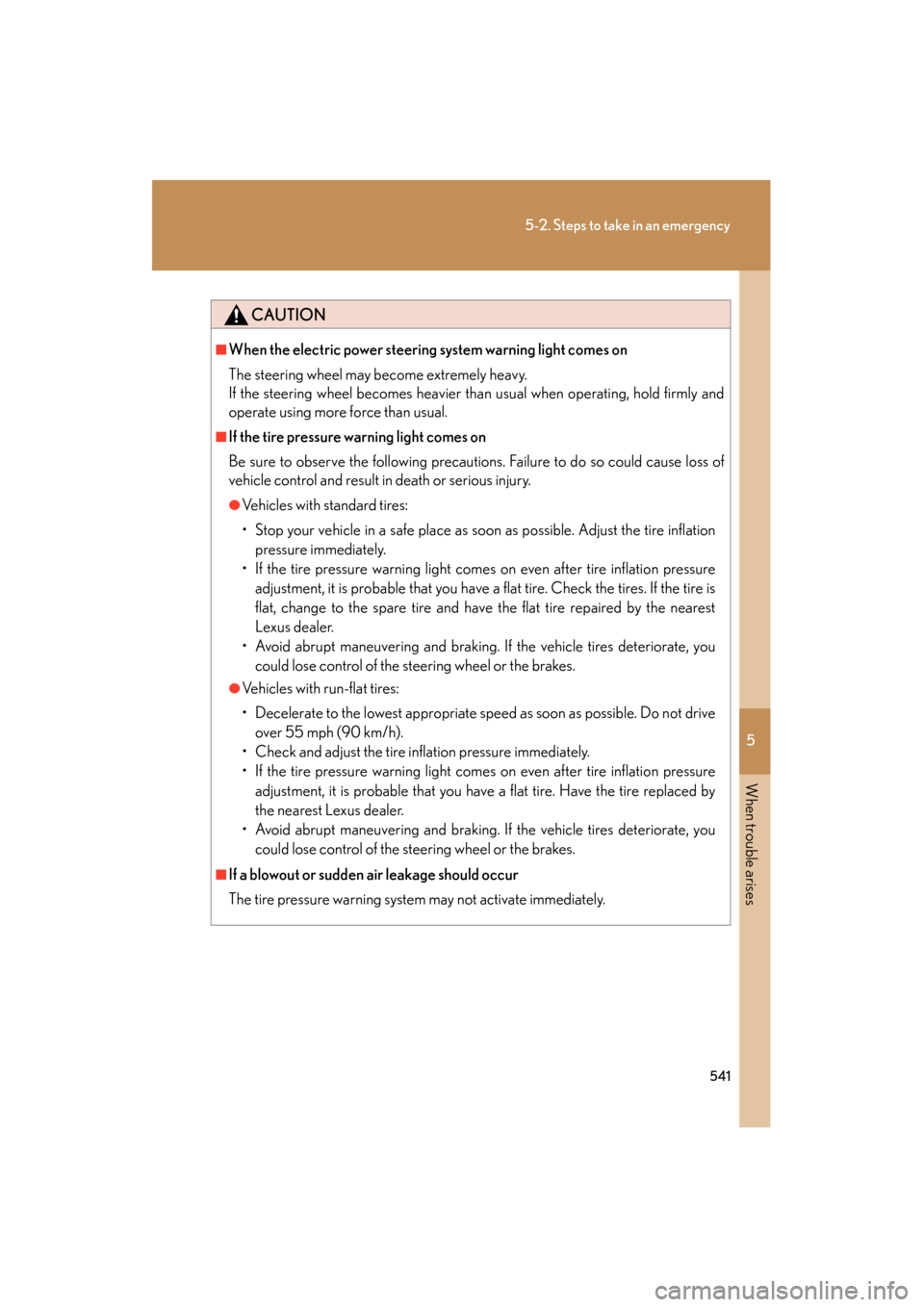
5
When trouble arises
541
5-2. Steps to take in an emergency
GS_G_U (OM30C11U)
October 28, 2011 5:15 pm
CAUTION
■When the electric power steering system warning light comes on
The steering wheel may become extremely heavy.
If the steering wheel becomes heavier than usual when operating, hold firmly and
operate using more force than usual.
■If the tire pressure warning light comes on
Be sure to observe the following precautions. Failure to do so could cause loss of
vehicle control and result in death or serious injury.
●Vehicles with standard tires:
• Stop your vehicle in a safe place as soon as possible. Adjust the tire inflationpressure immediately.
• If the tire pressure warning light comes on even after tire inflation pressure adjustment, it is probable that you have a flat tire. Check the tires. If the tire is
flat, change to the spare tire and have the flat tire repaired by the nearest
Lexus dealer.
• Avoid abrupt maneuvering and braking. If the vehicle tires deteriorate, you could lose control of the steering wheel or the brakes.
●Vehicles with run-flat tires:
• Decelerate to the lowest appropriate speed as soon as possible. Do not driveover 55 mph (90 km/h).
• Check and adjust the tire inflation pressure immediately.
• If the tire pressure warning light comes on even after tire inflation pressure
adjustment, it is probable that you have a flat tire. Have the tire replaced by
the nearest Lexus dealer.
• Avoid abrupt maneuvering and braking. If the vehicle tires deteriorate, you could lose control of the steering wheel or the brakes.
■If a blowout or sudden air leakage should occur
The tire pressure warning system may not activate immediately.
Page 543 of 654
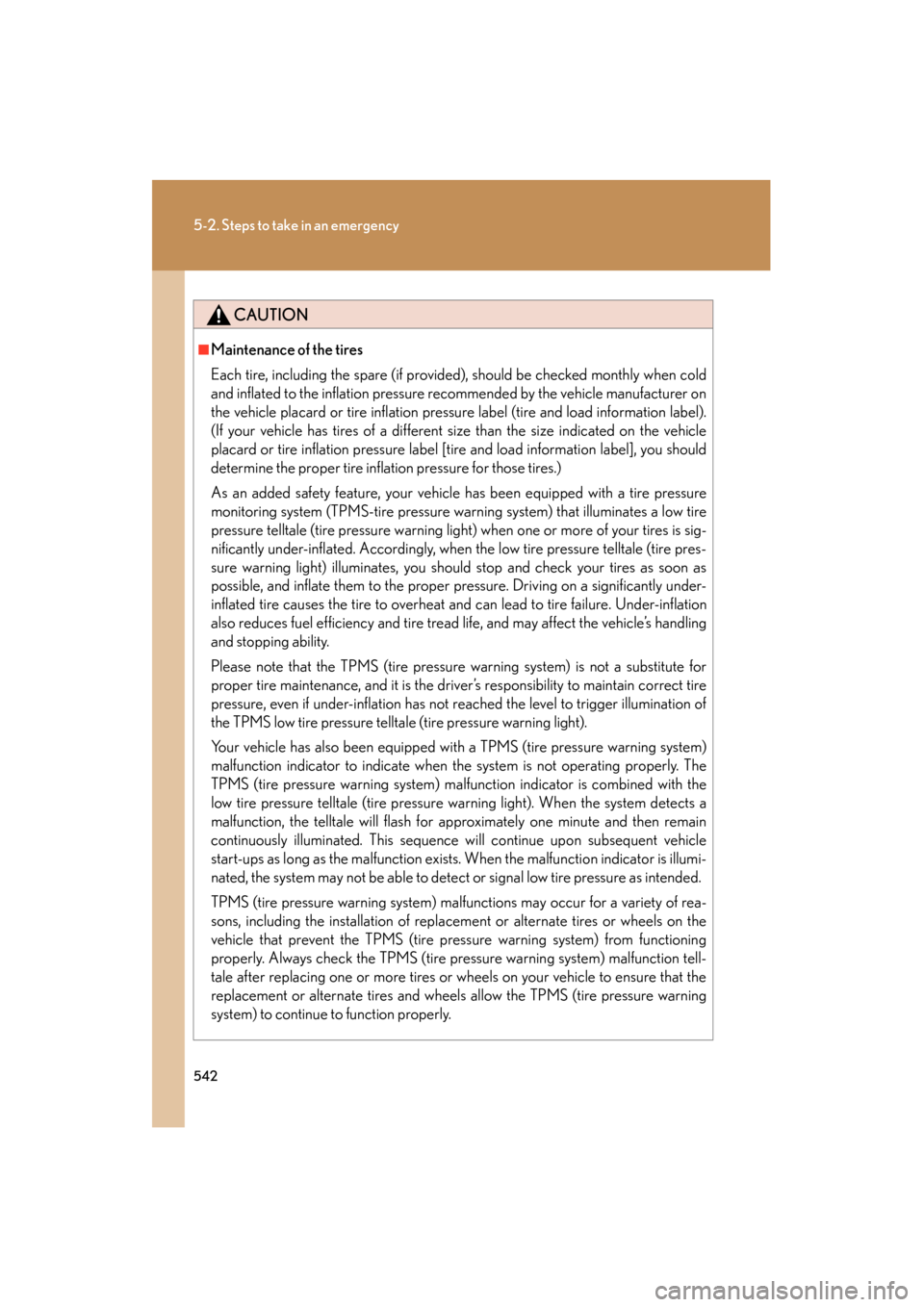
542
5-2. Steps to take in an emergency
GS_G_U (OM30C11U)
October 28, 2011 5:15 pm
CAUTION
■Maintenance of the tires
Each tire, including the spare (if provided), should be checked monthly when cold
and inflated to the inflation pressure recommended by the vehicle manufacturer on
the vehicle placard or tire inflation pressure label (tire and load information label).
(If your vehicle has tires of a different size than the size indicated on the vehicle
placard or tire inflation pressure label [tire and load information label], you should
determine the proper tire inflation pressure for those tires.)
As an added safety feature, your vehicle has been equipped with a tire pressure
monitoring system (TPMS-tire pressure warning system) that illuminates a low tire
pressure telltale (tire pressure warning light) when one or more of your tires is sig-
nificantly under-inflated. Accordingly, when the low tire pressure telltale (tire pres-
sure warning light) illuminates, you should stop and check your tires as soon as
possible, and inflate them to the proper pressure. Driving on a significantly under-
inflated tire causes the tire to overheat and can lead to tire failure. Under-inflation
also reduces fuel efficiency and tire tread life, and may affect the vehicle’s handling
and stopping ability.
Please note that the TPMS (tire pressure warning system) is not a substitute for
proper tire maintenance, and it is the driver’s responsibility to maintain correct tire
pressure, even if under-inflation has not reached the level to trigger illumination of
the TPMS low tire pressure telltale (tire pressure warning light).
Your vehicle has also been equipped with a TPMS (tire pressure warning system)
malfunction indicator to indicate when the system is not operating properly. The
TPMS (tire pressure warning system) malfunction indicator is combined with the
low tire pressure telltale (tire pressure warning light). When the system detects a
malfunction, the telltale will flash for approximately one minute and then remain
continuously illuminated. This sequence will continue upon subsequent vehicle
start-ups as long as the malfunction exists. When the malfunction indicator is illumi-
nated, the system may not be able to detect or signal low tire pressure as intended.
TPMS (tire pressure warning system) malfunctions may occur for a variety of rea-
sons, including the installation of replacement or alternate tires or wheels on the
vehicle that prevent the TPMS (tire pressure warning system) from functioning
properly. Always check the TPMS (tire pressure warning system) malfunction tell-
tale after replacing one or more tires or wheels on your vehicle to ensure that the
replacement or alternate tires and wheels allow the TPMS (tire pressure warning
system) to continue to function properly.
Page 558 of 654
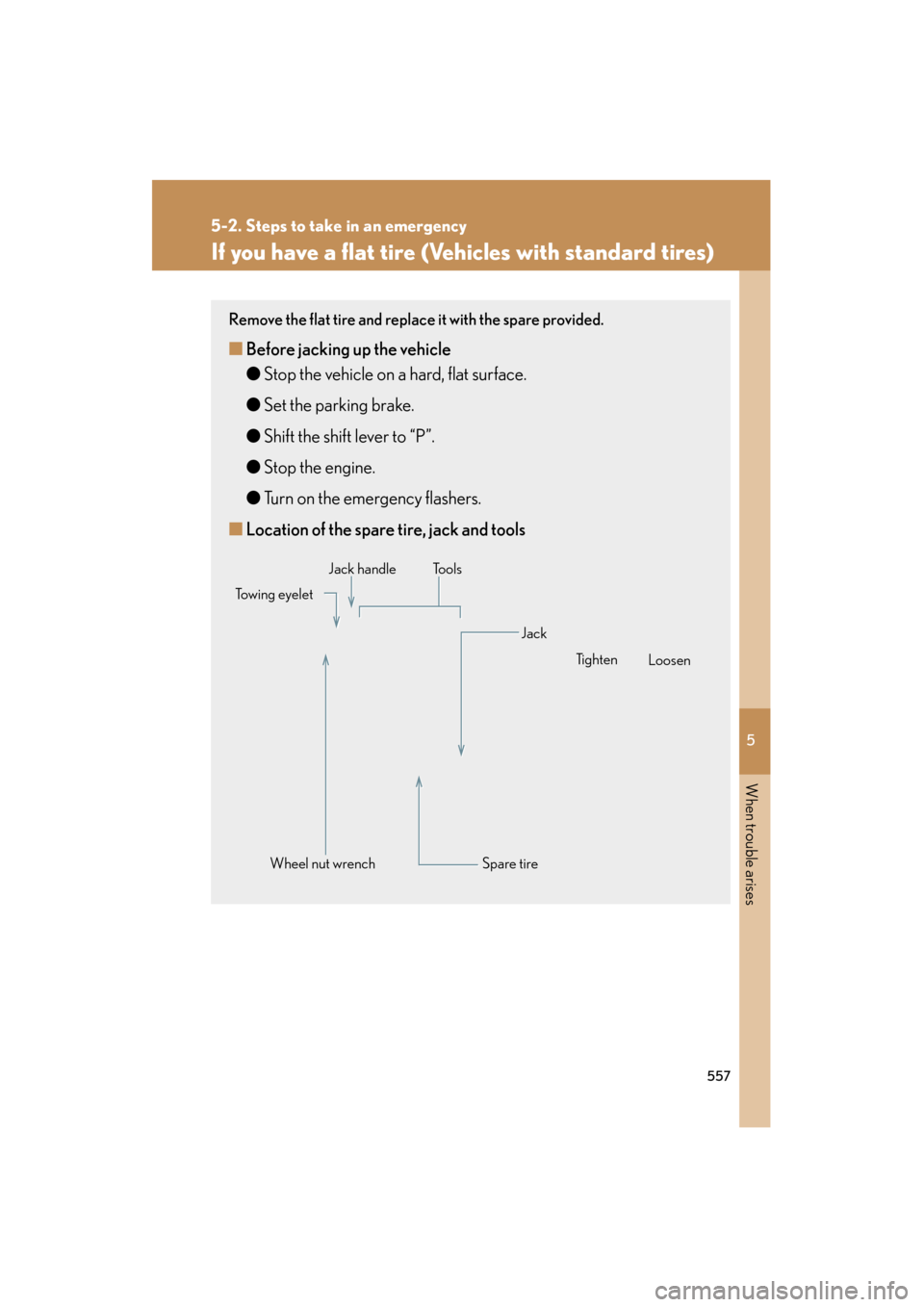
5
When trouble arises
557
5-2. Steps to take in an emergency
GS_G_U (OM30C11U)
October 28, 2011 5:15 pm
If you have a flat tire (Vehicles with standard tires)
Remove the flat tire and replace it with the spare provided.
■Before jacking up the vehicle
● Stop the vehicle on a hard, flat surface.
● Set the parking brake.
● Shift the shift lever to “P”.
● Stop the engine.
● Turn on the emergency flashers.
■ Location of the spare tire, jack and tools
Wheel nut wrench Jack
Jack handle
Spare tireTi g h t e n
Loosen
Tools
Towing eyelet
Page 563 of 654
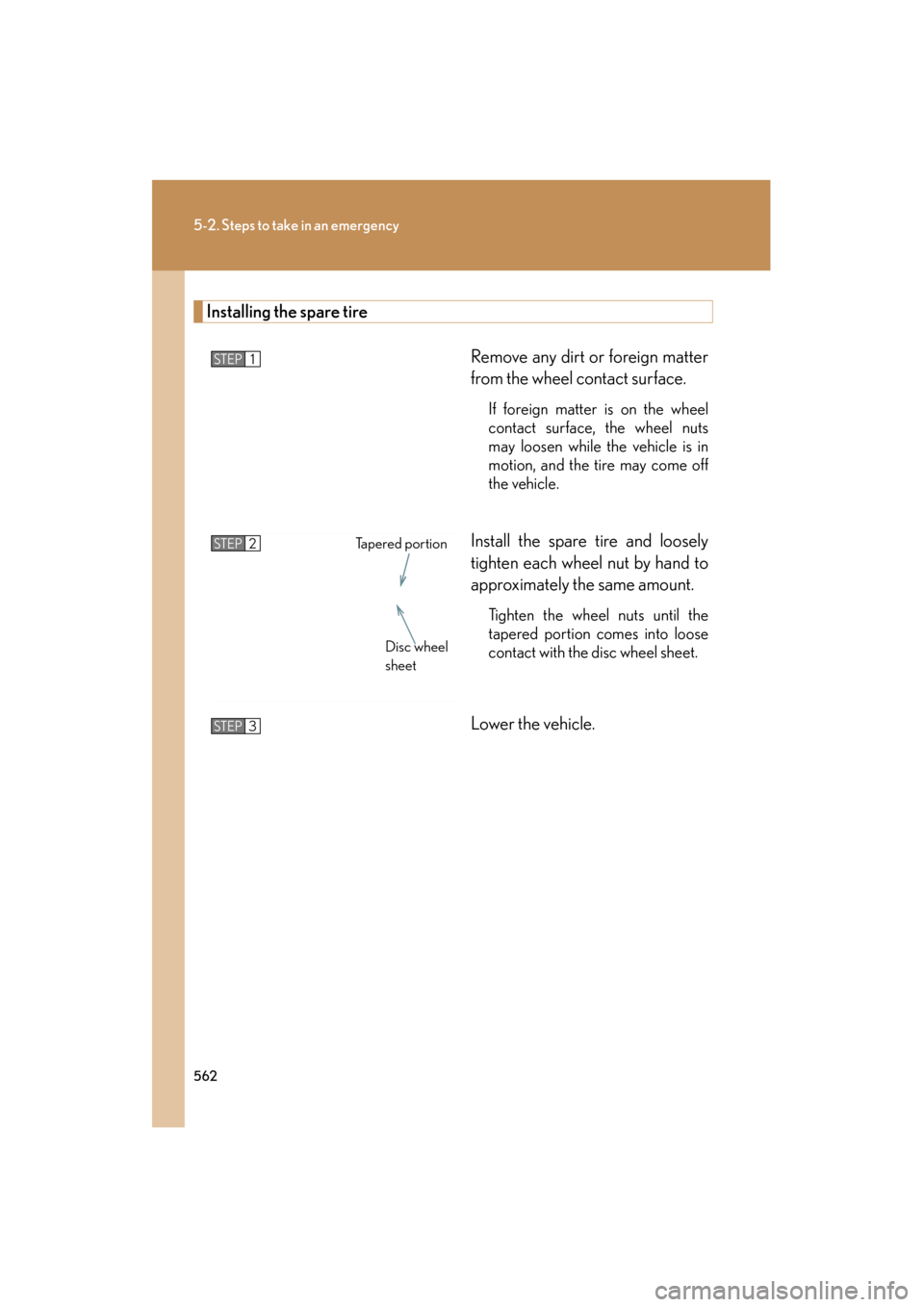
562
5-2. Steps to take in an emergency
GS_G_U (OM30C11U)
October 28, 2011 5:15 pm
Installing the spare tireRemove any dirt or foreign matter
from the wheel contact surface.
If foreign matter is on the wheel
contact surface, the wheel nuts
may loosen while the vehicle is in
motion, and the tire may come off
the vehicle.
Install the spare tire and loosely
tighten each wheel nut by hand to
approximately the same amount.
Tighten the wheel nuts until the
tapered portion comes into loose
contact with the disc wheel sheet.
Lower the vehicle.
STEP1
STEP2
Disc wheel
sheet
Tapered portion
STEP3
Page 567 of 654

566
5-2. Steps to take in an emergency
GS_G_U (OM30C11U)
October 28, 2011 5:15 pm
NOTICE
■Do not drive the vehicle with a flat tire
Do not continue driving with a flat tire.
Driving even a short distance with a flat tire can damage the tire and the wheel
beyond repair.
■Be careful when driving over bumps with the compact spare tire installed on the
vehicle
The vehicle becomes lower when driving with the compact spare tire compared to
when driving with standard tires. Be careful when driving over uneven road sur-
faces.
■Driving with tire chains and the compact spare tire
Do not fit tire chains to the compact spare tire.
Tire chains may damage the vehicle body and adversely affect driving performance.
■When replacing the tires
When removing or fitting the wheels, tires or the tire pressure warning valve and
transmitter, contact your Lexus dealer as the tire pressure warning valve and trans-
mitter may be damaged if not handled correctly.
■To avoid damage to the tire pressure warning valves and transmitters
When a tire is repaired with liquid sealants, the tire pressure warning valve and
transmitter may not operate properly. If a liquid sealant is used, contact your Lexus
dealer or other qualified service shop as soon as possible. Make sure to replace the
tire pressure warning valve and transmitter when replacing the tire. ( →P. 4 6 4 )
Page 568 of 654
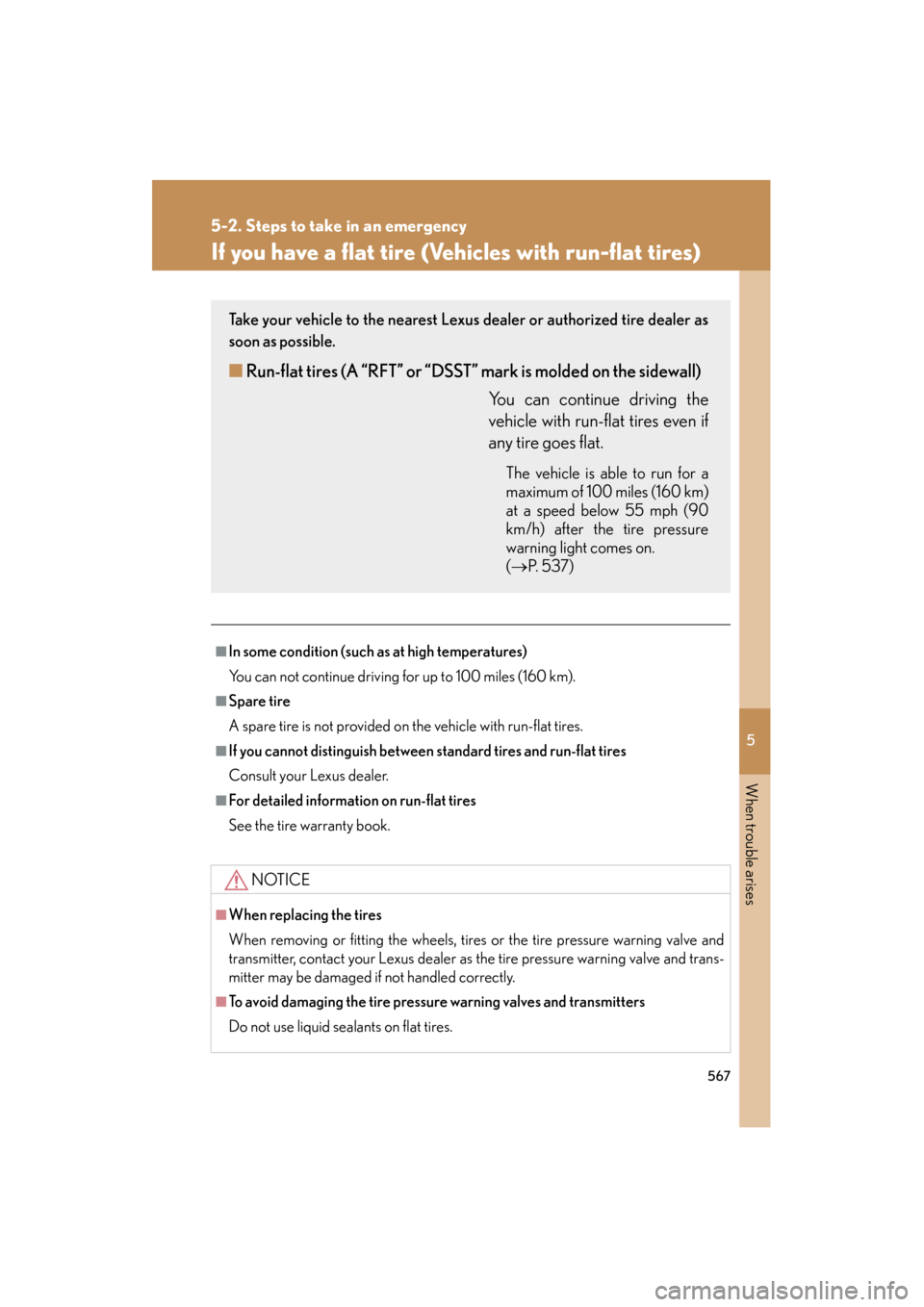
5
When trouble arises
567
5-2. Steps to take in an emergency
GS_G_U (OM30C11U)
October 28, 2011 5:15 pm
If you have a flat tire (Vehicles with run-flat tires)
■In some condition (such as at high temperatures)
You can not continue driving for up to 100 miles (160 km).
■Spare tire
A spare tire is not provided on the vehicle with run-flat tires.
■If you cannot distinguish between standard tires and run-flat tires
Consult your Lexus dealer.
■For detailed informatio n on run-flat tires
See the tire warranty book.
NOTICE
■When replacing the tires
When removing or fitting the wheels, tires or the tire pressure warning valve and
transmitter, contact your Lexus dealer as the tire pressure warning valve and trans-
mitter may be damaged if not handled correctly.
■To avoid damaging the tire pressu re warning valves and transmitters
Do not use liquid sealants on flat tires.
Take your vehicle to the nearest Lexus dealer or authorized tire dealer as
soon as possible.
■ Run-flat tires (A “RFT” or “DSST” mark is molded on the sidewall)
You can continue driving the
vehicle with run-flat tires even if
any tire goes flat.
The vehicle is able to run for a
maximum of 100 miles (160 km)
at a speed below 55 mph (90
km/h) after the tire pressure
warning light comes on.
(→ P. 5 3 7 )
Page 597 of 654

596
6-1. Specifications
GS_G_U (OM30C11U)
October 28, 2011 5:15 pm
Tires and wheels
Ty p e A
Ti r e s i z e
245/40R18 93Y, 245/40RF18 93Y,
P245/40R18 93V, P245/40RF18 93V,
245/40ZR18, T155/70D17 110M (spare)
Tire inflation
pressure
(Recommended cold tire inflation
pressure)
Driving under normal conditions
Front: 33 psi (230 kPa, 2.3 kgf/cm2 or bar)
Rear: 33 psi (230 kPa, 2.3 kgf/cm2 or bar)
Driving at high speeds above 100 mph (160
km/h) (in countries where such speeds are per-
mitted by law) Add 9 psi (60 kPa, 0.6 kgf/cm
2 or bar) to the
front tires and rear tires. Never exceed the
maximum cold tire inflation pressure indicated
on the tire sidewall.
Spare tire inflation pressure
(Recommended cold tire inflation
pressure)
60 psi (420 kPa, 4.2 kgf/cm2 or bar)
Wheel size18 × 8 J, 17 × 4T (spare)
Wheel nut torque76 ft•lbf (103 N•m, 10.5 kgf•m)
Page 598 of 654

597
6-1. Specifications
6
Vehicle specifications
GS_G_U (OM30C11U)
October 28, 2011 5:15 pm
Type B
Ti r e s i z e
225/50R17 94W, P225/50R17 93V,
P225/50RF17 93V,
T155/70D17 110M (spare)
Tire inflation
pressure
(Recommended cold tire inflation
pressure)
Driving under normal conditions
Front: 33 psi (230 kPa, 2.3 kgf/cm2 or bar)
Rear: 33 psi (230 kPa, 2.3 kgf/cm2 or bar)
Driving at high speeds above 100 mph (160
km/h) (in countries where such speeds are
permitted by law) Add 7 psi (50 kPa, 0.5 kgf/cm
2 or bar) to the
front tires and rear tires. Never exceed the
maximum cold tire inflation pressure indi-
cated on the tire sidewall.
Spare tire inflation pressure
(Recommended cold tire inflation
pressure)
60 psi (420 kPa, 4.2 kgf/cm2 or bar)
Wheel size17 × 7 1 /2 J, 17 × 4T (spare)
Wheel nut torque76 ft•lbf (103 N•m, 10.5 kgf•m)
Page 645 of 654
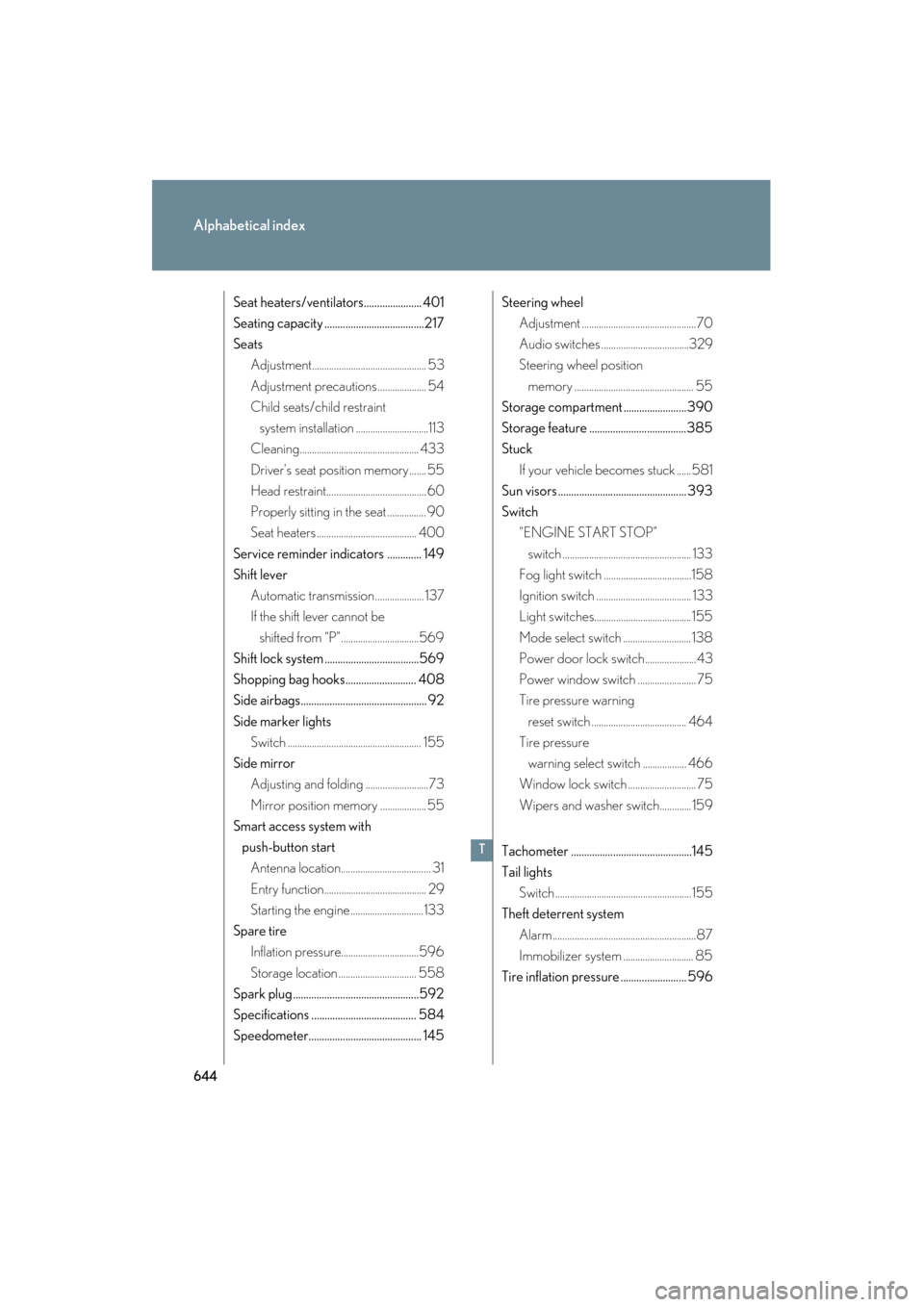
644
Alphabetical index
GS_G_U (OM30C11U)
October 28, 2011 5:15 pm
Seat heaters/ventilators...................... 401
Seating capacity ......................................217
SeatsAdjustment............................................... 53
Adjustment precautions.................... 54
Child seats/child restraint
system installation ..............................113
Cleaning................................................. 433
Driver’s seat position memory....... 55
Head restraint......................................... 60
Properly sitting in the seat ................ 90
Seat heaters ......................................... 400
Service reminder indicators ............. 149
Shift lever Automatic transmission.................... 137
If the shift lever cannot be shifted from “P”................................569
Shift lock system ....................................569
Shopping bag hooks........................... 408
Side airbags................................................ 92
Side marker lights Switch ....................................................... 155
Side mirror Adjusting and folding ..........................73
Mirror position memory ................... 55
Smart access system with
push-button startAntenna location..................................... 31
Entry function.......................................... 29
Starting the engine .............................. 133
Spare tire Inflation pressure................................596
Storage location ................................ 558
Spark plug ................................................592
Specifications ........................................ 584
Speedometer........................................... 145 Steering wheel
Adjustment ...............................................70
Audio switches ....................................329
Steering wheel position
memory ................................................. 55
Storage compartment ........................390
Storage feature .....................................385
Stuck
If your vehicle becomes stuck ......581
Sun visors ................................................. 393
Switch “ENGINE START STOP”
switch ..................................................... 133
Fog light switch ....................................158
Ignition switch ....................................... 133
Light switches........................................ 155
Mode select switch ............................ 138
Power door lock switch.....................43
Power window switch ........................ 75
Tire pressure warning
reset switch ....................................... 464
Tire pressure
warning select switch .................. 466
Window lock switch ............................ 75
Wipers and washer switch............. 159
Tachometer ..............................................145
Tail lights Switch ........................................................ 155
Theft deterrent system
Alarm...........................................................87
Immobilizer system ............................. 85
Tire inflation pressure ......................... 596
T